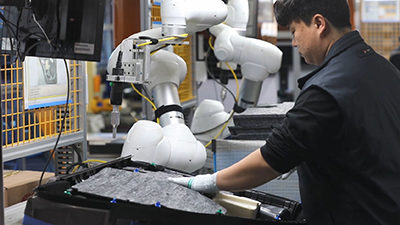Robotics sector responds to pandemic with rapid evolution
Business pressures lead to faster adoption cycles, rising popularity of subscription services, A3 says.

Pandemic pressures are rapidly changing the face of the industrial robotics industry, leading users to accelerate the rollout of new robots and to promote tighter collaboration between different types of technologies and the logistics employees around them, according to the robotics industry trade group The Association for Advancing Automation (A3).
The evolution comes as businesses across many sectors are looking for strategies to cope with the pressures of the covid crisis, such as labor shortages, social distancing restrictions, and a jump in demand for e-commerce and other goods.
Those factors have accelerated several trends that would eventually have happened anyway, A3 President Jeff Burnstein said in an interview during the group’s annual Automate Forward virtual trade show today.
For example, equipment vendors in recent years had frequently complained about “pilot purgatory,” the trend for customers to run trials of robotic platforms without ever moving on to large scale adoptions. But that scenario has become less common during 2020, as more companies swiftly purchased automated systems to keep their supply chains running, he said.
In another change, he said large corporations have become more open to the idea of Robotics as a Service (RaaS), an approach where customers pay monthly fees on a subscription basis instead of buying their robots outright. In exchange, vendors deliver products such as autonomous mobile robots (AMRs) and then provide tech support, hardware and software upgrades, and other ongoing support.
To adapt to the shifting industry, A3 itself is reorganizing, announcing yesterday that on April 14 it will bring its multiple constituent groups under a single umbrella. On that date, the four A3 associations—the Robotic Industries Association (RIA), AIA (Advanced Vision + Imaging), Motion Control & Motor Association (MCMA), and A3 Mexico—will converge into a single hub. The new arrangement will retain the current “Association for Advancing Automation” name and website.
The new approach reflects the industry’s move toward merging those multiple technologies together.
“Customers don’t want to go to a robotics website to learn about robotics, then a machine vision website to learn about machine vision, and so on,” Burnstein said. “When you need a robot, you might also need it to be able to grasp and to have vision and to have motion. The commonality between them is so strong that we decided to go with a single website.”
We invite you to join us for an exclusive SNEAK PEEK: Your First Look at the New Association for Advancing Automation at #AutomateForward! #motioncontrol #motor #artificialintelligence #robotics #machinevision Register for free today! https://t.co/4j5SaNjG1p pic.twitter.com/mMLAy5q8Vg
— Association for Advancing Automation (@a3automate) March 21, 2021
Related Articles

Copyright ©2024. All Rights ReservedDesign, CMS, Hosting & Web Development :: ePublishing